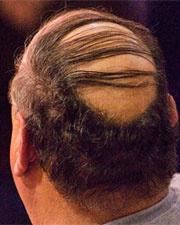 We’re off for a few days for the Thanksgiving holiday. We’ll be back with new posts on Monday!
We’re off for a few days for the Thanksgiving holiday. We’ll be back with new posts on Monday!
In the meantime, you can:
- Get active on the BaldingForum
- Follow us on Twitter
- Be our friend on Facebook
 We’re off for a few days for the Thanksgiving holiday. We’ll be back with new posts on Monday!
We’re off for a few days for the Thanksgiving holiday. We’ll be back with new posts on Monday!
In the meantime, you can:
Snippet from the article (unrelated to hair loss):
In a dramatic breakthrough that could affect millions of lives, scientists have been able to show for the first time that the body’s immune defences can destroy the common cold virus after it has actually invaded the inner sanctum of a human cell, a feat that was believed until now to be impossible.
The discovery opens the door to the development of a new class of antiviral drugs that work by enhancing this natural virus-killing machinery of the cell. Scientists believe the first clinical trials of new drugs based on the findings could begin within two to five years.
 Read the full story — A cure for the common cold may finally be achieved as a result of a remarkable discovery in a Cambridge laboratory
Read the full story — A cure for the common cold may finally be achieved as a result of a remarkable discovery in a Cambridge laboratory
We’ve all gotten sick from time to time, but could the common cold be a thing of the past within the next decade? We’ll have to wait and see. Lots of speculation considering the clinical trials won’t start for years from now.
Snippet from the article:
According to Spanish researchers, screenings for urinary symptoms in men with androgenetic alopecia (AGA, more commonly known as male-pattern baldness) could help with earlier identification of those who could benefit from treatment to prevent benign prostatic hyperplasia (BPH) and lower urinary tract symptoms (LUTS). Their rationale: Men with male-pattern baldness have higher than normal levels of 5-alpha-reductase, the chemical that converts the male hormone testosterone into dihydrotestosterone, the active form of male hormone within the prostate.
Male-pattern baldness, which accounts for almost all hair loss in men, results from a genetic malfunction that causes hair follicles to become more susceptible and shrink in the presence of dihydrotestosterone. Over time, the affected hair follicles stop producing hair. The chemical 5-alpha-reductase also plays a key role in the development of BPH. When testosterone is converted to the more potent dihydrotestosterone by 5-alpha-reductase, it can cause the prostate to enlarge, eventually leading to BPH and LUTS.
Read the full story — Male-Pattern Baldness and BPH: What’s the Connection?
In case you don’t want to read the whole thing, here’s a quick two sentence summary: If you’ve got genetic hair loss, you should get screened for prostate problems. The researchers found that in the 30 men they examined, all of them had larger prostates than the control group of men without hair loss.
(female)
I have always had yearly autumn hair shedding but since I had chemo 2 years ago this has stopped, do you have any ideas why this might be? Thanks.
Sorry, I’m not familiar with a possible reason for what you’re experiencing.
Just so I’m clear, you’re saying that your hair grew back after chemotherapy, but the seasonal shedding you normally experienced in the past has stopped, right? Have you talked with your oncologist about this?
I am a healthy 21 year old female. When my hair falls out, each strand has a white coating *surrounding* the white bulb. This ‘coating’ is usually white, also (sometimes it’s off-yellow). It’s a hard substance. You can scrape it off, and then you’ll see the normal white bulb.
Please help! What is this and what can be done? I am afraid it is causing hairloss.
The white coating is likely sebum, and this is normal. It isn’t causing hair loss. It is a regular part of hair anatomy that acts as the body’s own conditioner, of sorts.
Dear Doctor Rassman,
In your juvenile hairline post I noticed something. In all pictures you used overhead harsh lighting. Therefore you see scalp in the juveile hairline of the woman and the man, and in the mature hairline of the handsome lad ;), with hair that is combed back.
Is it normal to be able to see some scalp at the juvenile frontal hairline under harsh lighting? Is this what we call a transition zone?
I must compliment you on the honest pictures used on your site and blog. Amazing results! Keep up the good work with your blog.
Yes, you are on target with your thinking. Everyone has a see-through transition zone… and under harsh lighting more scalp will be visible.
Snippet from the article:
Other males may worry that losing their hair will make them less appealing. But for Guru the chimpanzee, his baldness has turned him into a star attraction. The 20-year-old, who is suffering from alopecia, has lost the hair from all over his body.
But the mischievous chimp still brings hundreds of visitors flocking to Mysore Zoo in southern India – despite greeting them by throwing stones. Dr Suresh Kumar, a zoo vet, said: ‘Everybody wants to see his biceps and triceps.
Read the full story (with many more photos) at DailyMail UK – Guru the chimp suffering from alopecia looks human
This is the 2nd bald chimp in the news this month. You may recall we mentioned Jambo the chimpanzee from the UK with alopecia… and now here’s Guru from India!
The article points out that Guru still gets down to business by throwing his poo at visitors to the zoo, so at least his alopecia hasn’t left him feeling depressed.
Hi Doctor,
I am assuming you’re attending the ISHRS meeting and was hoping you could attend the ACell discussion to report your opinion on your blog. Here’s the press release that caught my eye: MatriStem in Hair Restoration at Annual Scientific Meeting
Thanks
 I’m actually in Boston at the International Society for Hair Restoration (ISHRS) Scientific Meeting, and wrote this on my little netbook to get you a timely response.
I’m actually in Boston at the International Society for Hair Restoration (ISHRS) Scientific Meeting, and wrote this on my little netbook to get you a timely response.
The ACell material is reportedly derived from Porcine urinary bladder. Here’s a good, short description of ACell’s product from another conference they attended: “MatriStem® devices are a naturally occurring, completely resorbable, acellular, extracellular matrix. Different collagens, bioactive components and intact basement membrane help surgical sites remodel by supporting the growth of new blood vessels, connective tissue and muscle.”
At the ISHRS meeting, two doctors presented its use in plucked hairs. Hairs were plucked out of the beard or side hair and amongst these hairs the best ones were identified. The ACell was applied to the plucked hairs and then placed into recipient sites. Some of these hairs grew (less than 50%), but the good news is that supposedly the site where the hair was plucked also grew out a hair. The data is very sketchy and there is clearly no well identified process — no right way or wrong way to do this. But in theory, new hairs come from the process. If what was presented is accurate, then the dream of something for nothing (hairs that are essentially replicated) produces more hair than what was there prior to the procedure.
This MicroMatrix has experience of use in keloids, other types of wounds, and in the treatment of lacerations, ulcers of the skin (diabetic and vascular in origin), and burns. From what was presented, a great deal of interest was generated, but there is much research that needs to be done before it can or should be offered to the public. I suspect that the research will be on the fast track as many doctors saw the opportunity to make more hairs than they started with.
What are the benefits and drawbacks of head massage with oil? Some people get a vigorous head massage using olive/coconut oil. Whats your opinion?
 My opinion is that a head/scalp massage feels nice, and I quite enjoy the smell of coconut oil. Aside from relaxation and perhaps stress relief, massages with coconut or olive oil do not have any association with hair loss (if that is what you were asking). I’ve also read that the oils can help if you have a dry scalp, but I’ve never used them for that.
My opinion is that a head/scalp massage feels nice, and I quite enjoy the smell of coconut oil. Aside from relaxation and perhaps stress relief, massages with coconut or olive oil do not have any association with hair loss (if that is what you were asking). I’ve also read that the oils can help if you have a dry scalp, but I’ve never used them for that.
There are lots of claims about scalp massage being a way to treat hair loss due to helping with blood flow throughout the scalp, but blood flow issues aren’t usually the cause of hair loss. Genetics are the reason for the great majority of hair loss cases, not poor circulation.
Snippet from the article:
A study published in the Journal of the American Medical Association confirms that postmenopausal women who take combined hormone replacement therapy (HRT) are at an increased risk of dying from breast cancer.
“Women on combined hormone therapy with estrogen plus progestin were twice as likely to die from breast cancer compared to women receiving placebo,” says medical oncologist and study author Dr. Rowan Chlebowski.
The researchers looked at more than 16,000 postmenopausal women who were part of a large government study called the Women’s Health Initiative.
Read the full text at CNN – HRT increases breast cancer death risk, study confirms
This isn’t obviously about hair loss, but important information for the many women that read this site (or if your spouse, mother, sister, whomever is undergoing hormone replacement therapy).
Dr Rassman,
Hello and good day sir. I wanted to ask you a question but I first have to thank you for this wonderful resource you have provided here. My question is simple. This post is dated July 5th, 2007.
Have you finalized that baldness calculator yet? It sounds like an interesting tool and unless I missed an update in your archives (sorry if I did) I was hoping to see how that patent of yours is coming along. It would be nice to finally have a way to gauge how bald someone will become.
Your time is greatly appreciated. Thanks
The patent was filed but not ruled on by the patent office, which is now taking 3-5 years to process. We have held up doing more work on it until the US Patent office issues our patent, then we will have the economic advantage to produce it.
Here’s the patent application for those interested — Apparatus and Method for Mapping Hair Metric.
I am 28 years old. i started losing hair at the age of 22. 2 years before that on the top of my head red spots appeared and a diffuse pain in the roots of my hair(only on the upper area of the head). the quality of the hair on the top of my head changed noticeably. i went to a doctor, and he said it was the beginning of MPB. The pain is still here after 6 years. i tried a lot of different strategies to make it stop. the funny thing is that i still have my hair but the pain in the roots it’s still here too. when i scratch my head with my fingers the pain stops for some hours.
is it any possibility for this strange thing to happening due to bad blood circulation? Plus the skin on the top of my skull has become much harder. thanks in advance.
I do not know the source of your pain, but it does not seem related to the hair itself as you reported not losing any hair over the 6 years since being told you had early MPB. It may be a skin, scalp, or nerve problem.
There’s a large list of diseases that have scalp pain as a symptom, so I would get a second opinion from a doctor (perhaps a neurologist) that can examine your scalp to hopefully determine a cause.
Snippet from the story:
Jambo baldly goes where few chimps in a Brit zoo have gone before – after losing all his hair.
The 28-year-old suffers from the hair-loss disease alopecia.
Read the rest at The Sun UK
I’ve been reading about this bald chimpanzee for many years, so I’m glad to read that he’s still alive and popular with zoo visitors.
I found an article from 1997 about the same chimp that said he was regrowing his hair due because of a “secret cream made from goat’s milk and hedgerow plants” … but obviously that isn’t the case. I wish secret creams worked as well as advertised.
Dr Rassman, I was thinking of going in for an evaluation for a ht. I live in new england and because of my job i would not be able to travel beyond the northeast.
I’ve heard good things regarding Dr. Robert leonard. Do you have any recommendations for him or anyone else in New England.? best regard
Dr. Bernstein is in New York, and although I realize that’s not New England, he is closer to you than I am… plus, I know his work well and I trust his skills. He was a part of New Hair Institute for many years and now has his own practice.
Dr. Leonard also has long standing credentials in the field of hair restoration.
Saw this photo gallery someone put together of hilarious combovers. Thought you might like it too.
Link: The Art of the Combover
 It is important to understand that these hair styles evolve over years. I don’t think anyone just goes “Well, today is the day I finally cover up this bald head with some long hair from the side!”
It is important to understand that these hair styles evolve over years. I don’t think anyone just goes “Well, today is the day I finally cover up this bald head with some long hair from the side!”
This look starts when the hair loss is in the earliest stages and the changes brought about by these styles are barely seen. As the process of balding takes its toll and the balding pattern progresses, the combover becomes more evident until it’s an embarrassment for family and friends.
Those who produce these crazy styles never see them, practicing denial on a daily basis. What always amazed me was the wives, children and close friends never seemed to address the ridiculous appearance of the style with those who have them.
